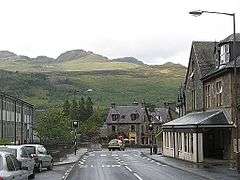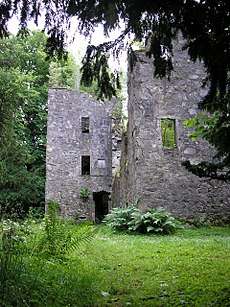Killin
Killin (/ˌkɪlˈɪn/; from Cill Fhinn 'the White [or Fair] Church' in Gaelic) is a village situated at the western head of Loch Tay in Stirling (formerly Perthshire), Scotland.
Killin
| |
|---|---|
 Main Street, Killin, with Meall nan Tarmachan in the background to the north | |
 Killin Location within the Stirling council area | |
| Population | 666 (2001 Census) |
| OS grid reference | NN572328 |
| Civil parish |
|
| Council area | |
| Lieutenancy area | |
| Country | Scotland |
| Sovereign state | United Kingdom |
| Post town | Killin |
| Postcode district | FK21 |
| Dialling code | 01567 |
| Police | Scotland |
| Fire | Scottish |
| Ambulance | Scottish |
| UK Parliament | |
| Scottish Parliament | |
The west end of the village is magnificently sited around the scenic Falls of Dochart, the main street leading down towards the Loch at the confluence of the rivers Dochart and Lochay. The falls are crossed by a narrow, multi-arched stone bridge carrying the main A827 road into Killin.
Killin railway station was on the Killin Railway. The railway station was officially closed on 1 November 1965.
Killin has a small primary school with 56 pupils. For secondary education pupils travel to Callander 21 miles (34 km) to the south. The nearest Gaelic medium primary is in Stirling, 37 miles (60 km) to the south.
History
The MacNab Clan were once dominant here, and have long been associated with Killin. Their ancient burial ground is on Inchbuie in the River Dochart, just below the falls, and is visible from the bridge.
Kinnell House was the seat of the MacNabs. A well-preserved prehistoric stone circle (possibly 'restored' to improve its appearance) known as Killin Stone Circle can be seen in the grounds of the house. To the north of the village lie the ruins of the Campbells of Breadalbane stronghold of Finlarig Castle, with its associated chapel. The growing power of the Campbells eventually ousted the MacNabs, who lost Kinnell House to their rivals. In 1694 Sir John Campbell of Glenorchy, 1st Earl of Breadalbane established Killin as a Burgh of barony. In 1949 Kinnell House and its estate returned to the ownership of the Chief of Clan Macnab, but in 1978 death duties forced the then Chief, James Charles Macnab of Macnab, to sell most of the estate.[1]
The Killin incident of 1749 took place in August 1749 in the tumultuous aftermath of the Jacobite rising of 1745.[2][3] Two men who had been plundering at will in full Highland dress after the Dress Act 1746 had made it illegal wear it, had been captured by soldiers of the British Army, but a large mob secured their release.[2][3]
In 1767 the minister of Killin, James Stuart, published the first New Testament in Scottish Gaelic.
By the end of the 18th century there was a local linen industry. Flax was grown locally, spun in small mills and woven into linen by home based weavers. Today, Killin services the local rural community and the growing tourism and leisure industries. In addition to walking on Ben Lawers National Nature Reserve, fishing for trout and salmon there are various watersports available on Loch Tay. Many local vernacular buildings have been preserved or converted, allowing the village to retain much of its historic character.
The 19th century Moirlanich Longhouse in nearby Glen Lochay is a rare surviving example of the cruck frame Scottish longhouse, and is now in the care of the National Trust for Scotland. The former Breadalbane Folklore Centre in the Victorian mill by the falls displays the 'healing stones' of Saint Fillan.
Tomnadashan Mine, an abandoned copper mine overlooking the village is sometimes identified as the haunt of the Rabbit of Caerbannog of Monty Python and the Holy Grail fame. Nearby Glen Lochay is the location to which Richard Hannay, played by Robert Donat, heads in the 1935 Alfred Hitchcock's film The 39 Steps.
Events
The village hosts the annual Killin Music Festival in June of each year. The festival was relaunched in 2016 by a local voluntary team.[4]
Notable people
- Rev Prof Patrick Campbell MacDougall FRSE (1806-1867), Professor of Moral Philosophy at the University of Edinburgh, born in the manse in Killin the son of Rev Hugh MacDougall[5]
Gallery
- Loch Tay, Killin with Ben Lawers on the left taken from a short distance up Sron a Chlachain.
- Hogmanay fireworks celebrations on the Bridge of Dochart, Killin.
 Breadalbane Visitor Centre, now Killin Water Mill, looking south east across the Falls of Dochart.
Breadalbane Visitor Centre, now Killin Water Mill, looking south east across the Falls of Dochart. Killin and Loch Tay from the sides of Sron a Chlachain.
Killin and Loch Tay from the sides of Sron a Chlachain. The Stewart Memorial[6] with the McLaren Hall in the background.
The Stewart Memorial[6] with the McLaren Hall in the background.- One of many scarecrows in the main street in Killin which are part of the annual Agricultural Festival.
 Falls of Dochart with the bridge.
Falls of Dochart with the bridge. Finlaring Castle in Killin.
Finlaring Castle in Killin.
References
- Know Your Chief Archived 2012-02-25 at the Wayback Machine at macnabclanuk.org, accessed 25 February 2012
- Harris, Robert (2002). Politics and the Nation: Britain in the Mid-Eighteenth Century. Oxford University Press. p. 177.
- Cunningham, A. D (1994). "A History of Rannoch, After the '45". Electric Scotland. Electric Scotland. Retrieved 8 September 2018.
- "New Killin music festival for 2016?". Retrieved 29 September 2015.
- "Prof. Patrick Campbell MacDougall d. Yes, date unknown: MacFarlane Clan & Families Genealogy". www.clanmacfarlanegenealogy.info. Retrieved 5 January 2018.
- MacKenzie, Gregor. "Stewart Memorial". Killin.info. Retrieved 23 June 2020.
External links
| Wikimedia Commons has media related to Killin. |
- Killin.info community website, guides, photos, media, news.
- Killin - A Village History
- Killin on the Gazetteer for Scotland